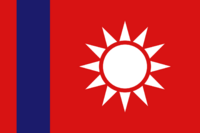Difference between revisions of "Luhainese"
m |
|||
| Line 32: | Line 32: | ||
[[Category:Silvitic Languages]] | [[Category:Silvitic Languages]] | ||
[[Category:Terraconserva Languages]] | [[Category:Terraconserva Languages]] | ||
| + | {{Monsilva topics}} | ||
Revision as of 14:38, 22 April 2024
| Luhainese | |
|---|---|
| |
| Native to | Monsilva (Meixian, Luhai and Leibo) |
| Ethnicity | Monsilvans |
Native speakers | 10 million (total) (2022) |
Byasa-Silvitic
| |
| Monsilvan characters (Pinyin) | |
| Official status | |
Official language in | |
Recognised minority language in | |
| Language codes | |
| ISO 639-3 | Luh |
Luhainese (Monsilvan: 绿海话; Haimao pinyin: Luhkhói wá) is a language within the Shan branch of the Byasa-Silvitic languages originating from the state of Luhai and eventually reaching the states of Meixian and Leibo. It is spoken by approximately 10 million people. Although they are mutually unintelligible when spoken, Luhainese is often considered a dialect of Monsilvan. The language is similar to Shaoyunese which uses the Iberic script instead of Monsilvan characters.
Luhainese is considered a vital part of the culture of Monsilvans living in the regions around the state of Luhai. The language faced risks of extinction multiple times throughout history. In 1984, Luhainese was made official in the states of Luhai, Meixian and Leibo, and is taught as part of the school curriculum by all state schools in those states. It is used as the main language in both the Luhai State Government and Leibo State Government, which has made subtitles mandatory on broadcasts of the government's meetings so that people who cannot understand Luhainese can still understand what is happening. Although it is not spoken as the main language in the Meixian State Government, when meetings involving representatives from only the northern municipalities, they often use Luhainese.
Although Luhainese shares much vocabulary with Standard Monsilvan, they are mutually unintelligible, largely because of phonological differences, but also due to differences in grammar and vocabulary. Sentence structure, in particular the placement of verbs, sometimes differs between the two varieties. A notable difference between Luhainese and Standard is how the spoken word is written; both can be recorded verbatim, but very few Luhainese speakers are knowledgeable in the full Luhainese written vocabulary, so a non-verbatim formalized written form is adopted, which is more akin to the Standard written form. This results in Luhainese and Standard using the same characters to spell words, but pronouce them completely differently. A Luhainese and Standard speaker can both read writing from one another's languages, however they likely wouldn't understand each other if they spoke.
According to the March 2022 Census, zero people reported being able to speak Luhainese, but not Standard. This is the first time that there were no respondants to any question on a census in Monsilvan history. In the previous census, only 200 people reported being only able to speak Luhainese. Although schools teach both Standard and Luhainese, Luhainese is taught as a secondary, while other subjects would be taught in Standard. This is likely why the number of Luhainese speakers is slowly decreasing, and likely contributed to the extinction of monolingual Luhainese speakers. However, around 9 million reported being able to speak both Luhainese and Standard, but use Luhainese more often in conversation. While around 1 million reported being able to speak both Luhainese and Standard, but use Standard more often in conversation. About 980k (98%) of that 1 million lived outside of Luhai and Leibo.

